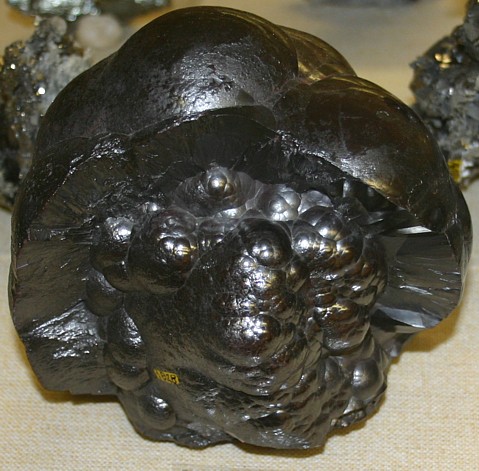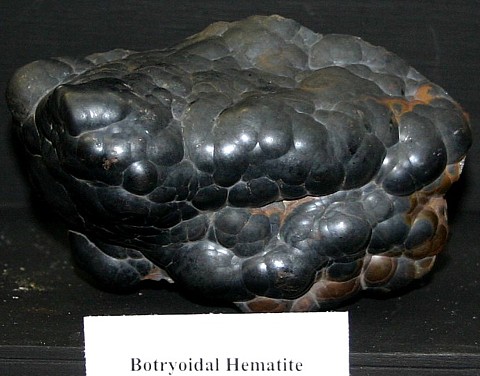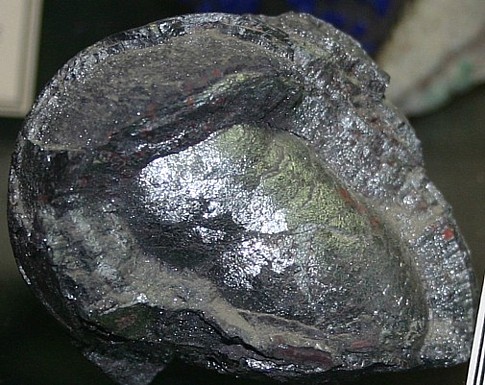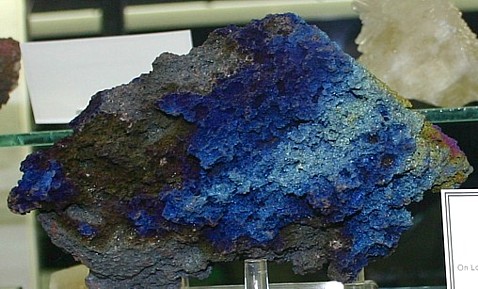|
.
Hematite Mineral Facts:
Chemical Formula: Fe2O3
Oxide of
iron, containing Iron, 72.4 per cent.
Colors:
Steel grey or iron black. Streak
and earthy forms are red.
Hardness:
5.5 to 6.5
Hardness varies somewhat depending
on porosity.
Density: 5.2
The density
is high because of the large iron content.
Cleavage:
None. Fracture
subconchoidal or uneven.
Crystallography: Rhombohedral
Luster:.
Metallic luster when
well crystalized. Other forms may be earthy and dull.
Optics:
(Refractive Index): Opaque
|
 |
|
Composition,
Structure and Associated Minerals:
Hematite
is one of the most important minerals, if not the most important one, from
the economic standpoint, since it is the most valuable of all the iron ores.
It is known by its dark color and its red powder. It occurs in black,
glistening crystals, in yellow, brown or red earthy masses, in granular and
micaceous aggregates and in botryoidal and stalactitic forms.
The
crystals are often tabular, and sometimes are grouped into aggregates
resembling rosettes. In many cases the
terminal faces are rounded. A
parting is often observed parallel to
the basal plane, due to the occurrence of the mineral in aggregates in which
each crystal is tabular.
Usually
earthy or in botryoidal to reniform shapes with radiating structure. At
times micaceous; crystallized. The crystalline and earthy aggregates of
hematite to which distinct names have been given are:
Specular:
when the aggregate consists of grains with a glistening,metallic luster,
like the luster of the crystals. When the grains are thin tabular the
aggregate is said to be micaceous.
Kidney Ore: Columnar or fibrous form,
also in fibrous masses. The color is usually brownish red and the luster
dull. The botryoidal, stalactic and various imitative forms belong here. Red
hematite is a compact red variety in which the fibrous structure is not very
pronounced.
Red Ocher is a red earthy hematite mixed
with more or less clay and other impurities. Clay ironstone is a hard
brownish or reddish variety with a dull luster. It is usually a mixture of
hematite with sand or clay.
Oolitic Ore is a red variety composed of
compacted spherical or nearly spherical grains that have a concentric
structure.Fossil ore differs from oolitic ere mainly in the fact that there
are present in it small shells and fragments of shells that are now composed
entirely of hematite.
Identification and Diagnostics
Infusible.
Becomes strongly magnetic on heating in the reducing flame. Slowly soluble
in hydrochloric acid; solution with potassium ferrocyanide gives dark blue
precipitate (test for ferric iron). Told chiefly by its characteristic
Indian-red streak, and the fact it becomes magnetic after heating.
|

 |
|
|
Occurrence,
Localities and Origins:
Hematite is a
widely distributed mineral in rocks of all ages and forms the most abundant
ore of iron. Occurs as an accessory mineral in feldspathic igneous rocks,
such as granite. Found from microscopic scales to enormous masses in
connection with metamorphic rocks. It is found in red sandstones as the
cementing material that binds the quartz grains together. The crystallized
variety is found at many places, more particularly from the island of
Elba; St. Gothard, Switzerland, in iron roses; in the lavas of Vesuvius; at
Cleator Moor, Cumberland, etc. In the United States the columnar and earthy
varieties are found in enormous beds that furnish a large proportion of the
iron ore of the world. The chief iron-ore districts of the United States are
grouped around the southern and northwestern shores of Lake Superior in
Michigan, Wisconsin and Minnesota. The chief districts, which are spoken of
as iron-ore ranges, are, from east to west, the Marquette Range in northern
Michigan; the Menominee Range in Michigan to the southwest of the Marquette;
the Penokee-Gogebic Range in northern Wisconsin; the Mesabi Range, north of
Duluth in Minnesota; and the Vermillion Range farther north in Minnesota,
near the Canadian boundary. The iron ore of these different ranges varies
from the hard black micaceous specular variety to the soft red earthy type.
All of the ore bodies lie in rock troughs which furnish impervious
underlying basements to the deposits. In all of the districts, except the
Mesabi, these underlying rocks are in the nature of altered igneous dikes,
known as soapstone dikes. The ore bodies lie in more or less broken quartz
material, frequently colored red by inclusions of hematite and called
jasper. The origin of these deposits is attributed to the slow concentration
of the iron content of a siliceous carbonate rock by downward moving waters.
These waters were at last collected in the impervious rock troughs and there
deposited their iron content by a replacement of the quartz of the overlying
rock. The ores are mined in part by underground methods, and in part, where
the ore is soft and lies sufficiently near the surface, by the use of steam
shovels. Hematite is also found in the United States in various places in
connection with the outcrop of rocks of the Clinton formation, from central
New York south along the line of the Appalachian Mountains to central
Alabama. The most important deposits of the series lie in eastern Tennessee
and northern Alabama, near Birmingham. Hematite has been found at Iron
Mountain and Pilot Knob in southeastern Missouri. Deposits of considerable
importance are located in Wyoming, in Laramie and Carbon counties.
Return to the
Mineral Collectors Information Page |
|




